There are many, many needlework threads on the market that are sold in looped twists.
This type of “put up” (the method in which the thread is “bundled” or “presented” for selling) is pretty common, but if you haven’t come across it before and you don’t know how to handle it, it can be frustrating.
The specific put-up I’m talking about are those threads that begin in large loops that are then folded and then twisted.
The Gumnut Yarns that we talked about the other day are sold this way, but it’s not the only thread out there that’s put up in this configuration.
The loop and twist put-up is super-common in needlework threads. Perle cotton (DMC perle cotton #3 and #5) come this way. Cotton floche comes in a looped put-up (though not a twist). Many, many needlepoint threads come in looped and twisted put-ups.
Once you know how to handle one type of thread that comes this way, you’ll be able to handle any of them! So let’s talk about how to handle these looped and twisted threads, using the Gumnut skeins as an example.
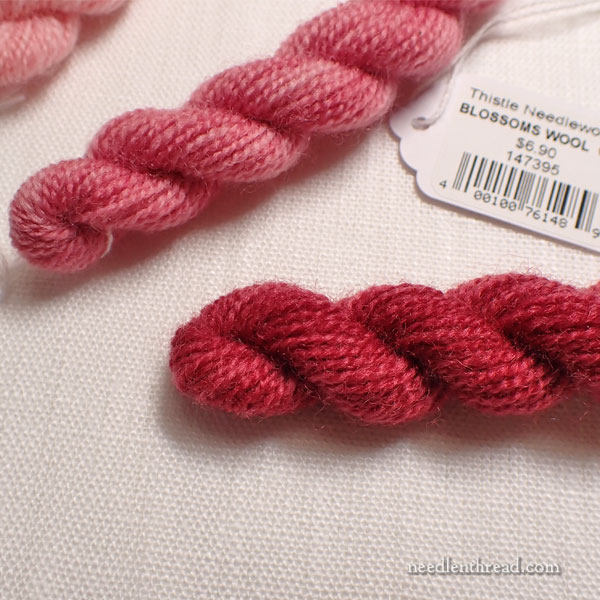
In the embroidery world, most of us are very familiar with the typical skein of stranded cotton (or “embroidery floss” as it’s called in the States). The ubiquitous DMC floss (or Anchor, or Cosmo, or any other brand or non-brand) is normally sold in a put-up called a “pull skein.”
The concept of a pull skein is that you can pull the cut end of the floss from the skein and (if all goes as intended by the manufacturer and hoped-for by the stitcher), the embroidery thread will pull straight out of the skein, while the tabs on the skein all stay neatly in place. The whole experience, when it works correctly, is rather a satisfactory, pleasant experience.
But if you’ve been stitching for a while, you know it doesn’t always work this way, and the pull-skein can end up being super-frustrating. You can read about how to handle a pull-skein here, how they’re supposed to work, and so forth.
The pull skein is pretty nice, when it works the way it’s supposed to.
But twists don’t ever work like pull skeins. They are not made so that you can find the cut end of thread and just pull out the length you want to use.
If you try that, you’re going to end up with a heap of frustration all bound up in a mass of thread.
It’s just not pleasant.
So you have to tackle a twist with a bit of strategy. If you’re using twists, it helps to prepare your threads before you are ready to start stitching.
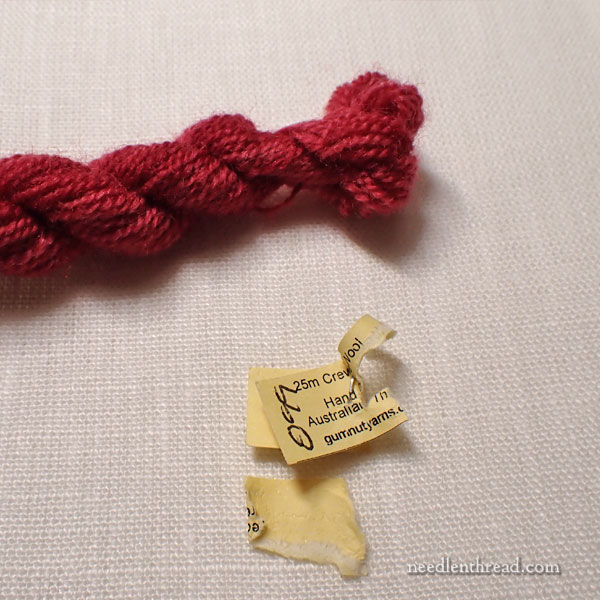
Most twists have tags on them somewhere.
With Gumnut Yarns, you might find two tags (this is how I’ve found them sold in the States). At the folded end of the twist, you’ll find a white number and price tag that’s attached to a string. This is shown in the first photo above.
Remove that tag and set it aside.
You’ll also find the manufacturer’s tag (pictured immediately above) at the base of the twist – this is the brand tag, also sporting the thread type and color number (which is hand-written). This tag is stapled tightly around the base of the twist, holding the two sides of the twist together. Think of it as a choke-hold at the base of the twist, that keeps the twist from untwisting.
In fact, this tag is my only pet peeve with Gumnut Yarns. I’m not a huge fan of stapled tags on threads, because those little staples inevitably snag the threads.
Anyway, remove this tag, too. If you have a white threaded tag on your twists, you don’t need to save the manufacturer’s tag, because the white threaded tag has all the information you need on it. It’s just easier to tear off the manufacturer’s tag, staple and all, and get rid of it.
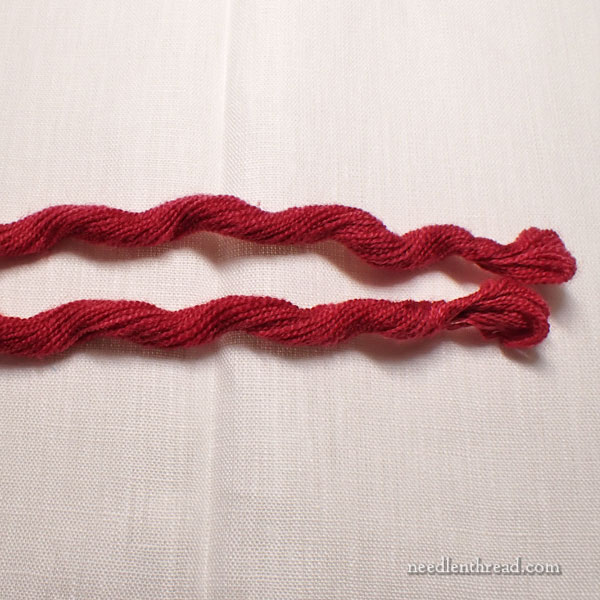
Once you have that tag off, the twist will untwist and you can unfold it. You’ll end up with an unfolded length of thread that is about twice as long (and half as thin) as the original twisted skein.
In the photo above, I have the two ends lying next to each other, and the thread is no longer tightly twisted together.
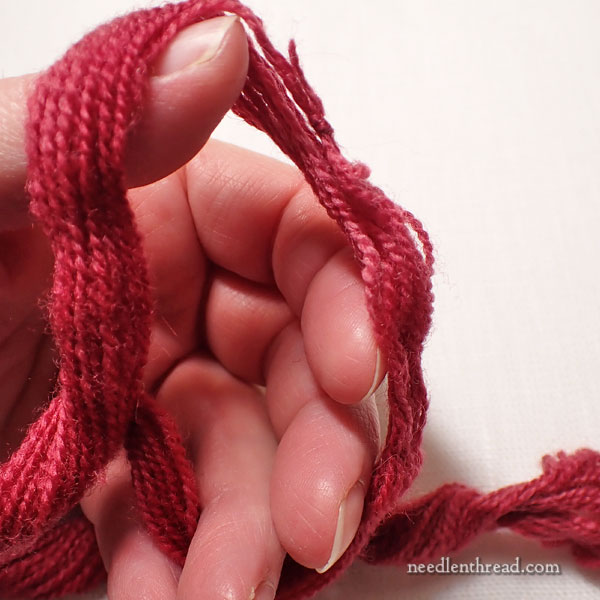
This is actually one big loop of thread at this point. The “ends” of the thread are actually the “turns” in the loop. If you carefully separate the ends so that you form a big loop with the thread, you’ll see, somewhere along that loop – and likely near the folded end of one side or the other – the knot that ties the beginning and end of the looped thread together.
If you just cut that knot and nothing else, and try to start pulling out lengths of thread, you will end up with a jolly mess!
So don’t do that!
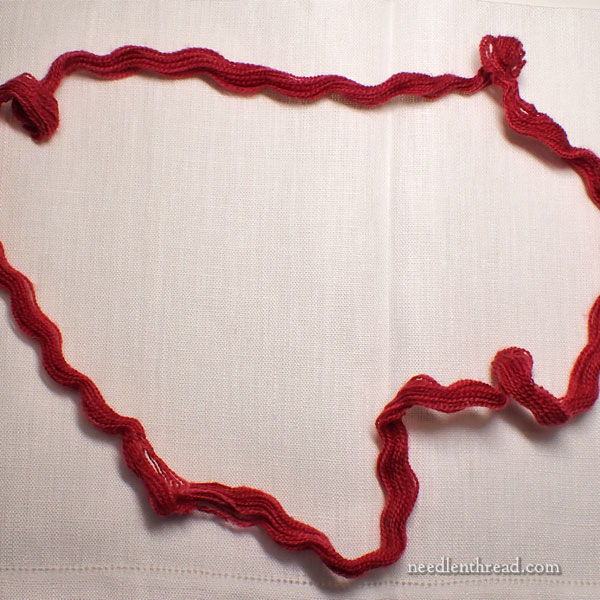
Instead, open the loop up and lay it out, so it’s a nice, big loop on your tabletop.
See the big loop?
I haven’t cut anything at this point. I’ve made sure that the threads are all aligned with the side of the loop that they were originally looped into – so that the whole loop is a continuous group of threads.
Now we’re ready to do something with them.
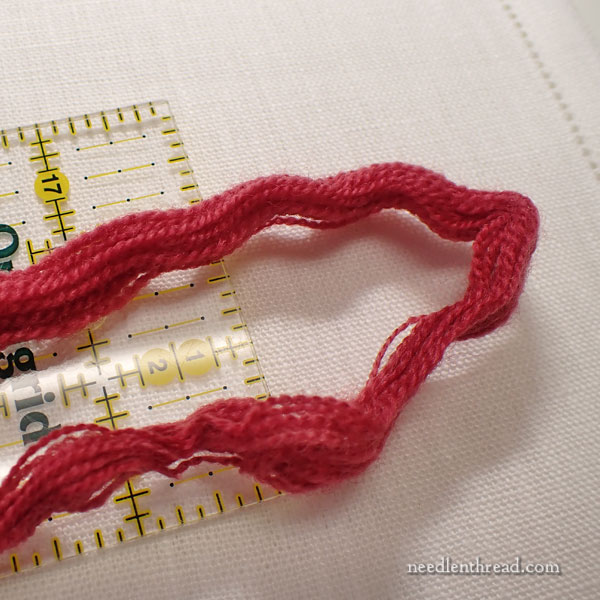
If I stretch the big loop out, I notice that the loop is about 20″ long. This means if I cut one side of the loop, I’ll end up with individual thread lengths of about 40″.
If I cut both sides of the loop where the “turn” is, I’ll end up with individual lengths of thread that are 20″ long.
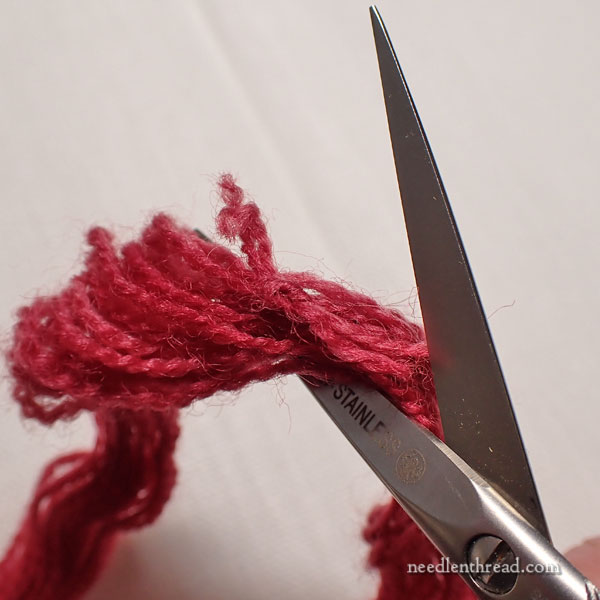
20″ is a good length to stitch with, for most threads. With some wools, though, I would find 20″ too long, as the wool would pill.
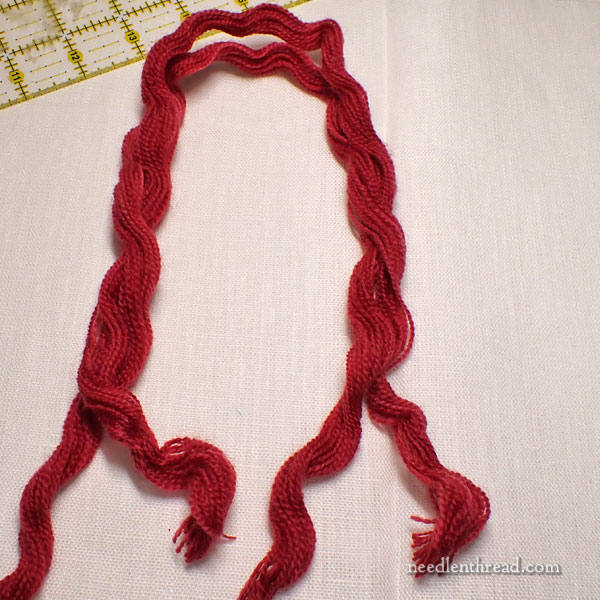
But Gumnut Yarns do fine at 20″. So I cut both sides of the large loop, to create a big bundle of pre-cut 20″ lengths of thread, ready for stitching with.
Now you’ll need to contrive a way to keep this cut bundle in order and labeled.

You could loop the threads onto a thread drop or something similar that you’ve labeled with the needful information about the thread – thread type, color number – and this would be a handy way to keep the thread under control.
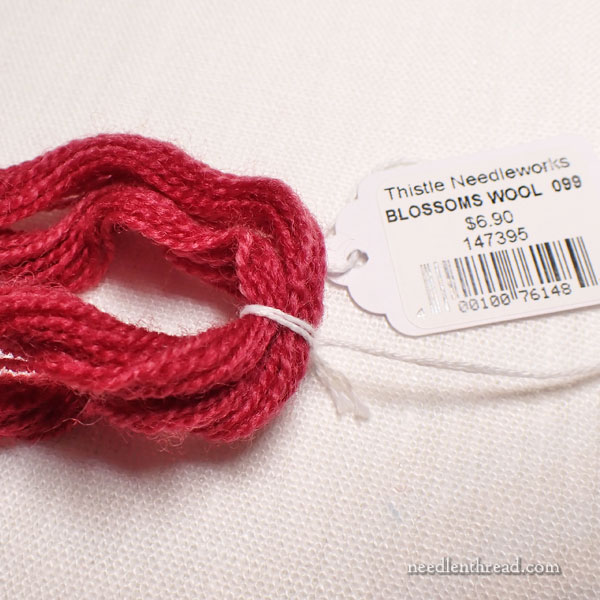
Or, if you saved the white hang tag from the beginning of this process, you can simply hitch it back onto the bundle of threads and you’ll be good to go!
This is the same process you can use with any kind of looped, twisted needlework threads, to get them cut and ready to stitch with. The only variation that you have to deal with is the type of tag that comes on the original twist.
If you can use the original tag with your pre-cut lengths, that’s great! If you can’t, just make sure you save the correct information about the thread (especially type and color number) for whatever new tag you’ll use to hold the threads together.
And that, my friends, is how you handle looped and twisted thread put-ups.
More Information on Thread Organization
If you’d like more information on handling embroidery threads, check out these articles:
Unraveling the Secrets of the Pull Skein – how to effectively use a pull skein as its meant to be used (please note: it has nothing to do with the circular arrow on the number tag, a point addressed in this article).
How to Strip Embroidery Floss (separating floss)








Thanks so much for this information about Gumnuts Blossom Yarn! especially that 20 inch lengths are good to work with.
I am wondering, however, how you handle yarns & threads that aren’t easily divisible (like this one is) to get the lengths you want? Or, if you want different lengths at different times (i.e. 15″ AND 20″)? Or, if you don’t know what length will work best? Is the only other option to roll them into a ball?
Thank you,
laura
Then I cut them as I need them.
What do you do with Watercolour threads when you want to continue the color so there isn’t an abrupt change in the shading? I ended up unwinding the whole length and then pulling one strand. I wound it on a bobbin. The loose end be the first stitch. The end I cut off the bobbin will be the needle end.
Hi Mary, thank you for this really good article on opening looped threads. As an Australian I absolutely love gumnut threads, the soft Merino wool, silk and silk /wool blends are a joy to use, but like you, undoing the loop and cutting and setting up the thread is an absolute pain, the staple is frequently through the fibres in the skein and pulls when you are trying to sort the thread and in Australia we seem to be penalised by not having the white tag and all its details to attach onto the thread after sorting, what a great help that would be. However, I love the slight variegation in the colours and they handle beautifully. So I will continue to use them and complain to myself every time I have to sort and set them up.